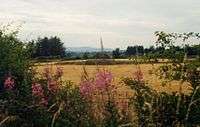Altmore
Altmore (Irish: Alt Mór (Great Glen)[1]) is a hamlet and townland in County Tyrone, Northern Ireland. It is five miles from Carrickmore and four miles from Pomeroy. The townland is actually called Altmore (alias Barracktown) and is situated in the historic barony of Dungannon Middle and the civil parish of Pomeroy and covers an area of 1117 acres.[2] Most of the community consists of farmers who make their livelihood in cattle and pig farming. It is an isolated area, though easily accessible and the natural beauty has remained untouched.
The population of the townland declined during the 19th century:[3][4]
| Year | 1841 | 1851 | 1861 | 1871 | 1881 | 1891 |
|---|---|---|---|---|---|---|
| Population | 222 | 183 | 226 | 231 | 206 | 160 |
| Houses | 46 | 36 | 46 | 48 | 49 | 42 |
The townland contains two Scheduled Historic Monuments: a Megalith (grid ref: H6710 6936) and a court tomb (grid ref: H6686 6961)[5]
Places of interest

- The scenery around Altmore is breathtaking, and the Mountains of Pomeroy are a dominating feature in the landscape. Ancient relics can be seen on country lanes. Their origin is unknown though they may be ancient burial grounds dating back as far as three thousand years. These can be seen at various stages on roadways along Altmore. Though modern farming methods have diminished a number of them visibly a few can still be seen.
- Altmore Fisheries - a small holiday place where locals and visitors can relax with children and stay in a caravan site. It is an ideal stop-over site for ramblers who enjoy an area of Ireland that is seldom explored and enjoy the benefit of a landscape and way of life that has changed little over the years. The site comprises static caravans and areas to erect tents; there are also log cabins which can be rented and a small shop on site.
- Altmore House - The House was built after 1734 by Patrick Shields. He married Susannah Morris the daughter of the High Sheriff of Tyrone. He had been appointed keeper of a deserted barracks higher up the mountain. That premises was converted into Barracktown House also a Shields Family Home. The Family lived permanently in the House until the 1970s when it was sold and turned into a hotel. The Hotel was blown up during the troubles on two occasions and after many years of dormancy the ruins were eventually knocked down. The House was the birthplace of James Shields who became a well-known politician in North America (being the only person to have served as a United States Senator from three different states) and a well known name during the American Civil War.
- Shane Bernagh’s Chair - this is a small rocky area on the outskirts of Cappagh and Altmore. It received its fame from the highwayman Shane Bernagh Donnelly, who used the mountain area as a vantage point to hold up carriages travelling on the main Dublin to Derry road nearby. Local legend has it that the highwayman assisted impoverished locals with his robberies, mainly from English gentry and English soldiers. A barracks was built in the Altmore area in an attempt to curb his activities but to little avail. Because of this Bernagh has over time become a local legend in the mould of Robin Hood who robbed from the rich and gave to the poor. He was eventually captured and executed by the English. His body was cast into a lough at the summit of Slieve Beagh, which straddles the counties of Tyrone, Fermanagh and Monaghan. He was immortalised further by the local scholar Dr. George Sigerson in his popular ballad "The Mountains of Pomeroy". The actual rocky area looks like a chair and has thus become known as Shane Bernagh’s Chair.
-

Shane Bernagh’s Chair May 2007
-

View from Shane Bernagh’s Chair. Looking towards Altmore May 2007.
See also
| Wikimedia Commons has media related to Altmore. |
References
- ↑ "Altmore". Place Names NI. Retrieved 18 March 2013.
- ↑ "Townlands of County Tyrone". IreAtlas Townland Database. Retrieved 12 December 2012.
- ↑ "Census of Ireland 1851". Enhanced Parliamentary Papers on Ireland. Retrieved 12 December 2012.
- ↑ "Census of Ireland 1891". Enhanced Parliamentary Papers on Ireland. Retrieved 28 December 2012.
- ↑ "Scheduled Historic Monuments (to 15 October 2012)" (PDF). NI Environment Agency. Retrieved 12 December 2012.
Coordinates: 54°33′15″N 6°59′10″W / 54.55417°N 6.98611°W